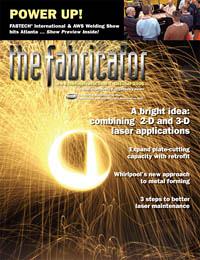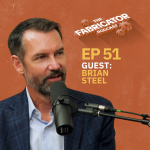Contributing Writer
- FMA
- The Fabricator
- FABTECH
- Canadian Metalworking
Categories
- Additive Manufacturing
- Aluminum Welding
- Arc Welding
- Assembly and Joining
- Automation and Robotics
- Bending and Forming
- Consumables
- Cutting and Weld Prep
- Electric Vehicles
- En Español
- Finishing
- Hydroforming
- Laser Cutting
- Laser Welding
- Machining
- Manufacturing Software
- Materials Handling
- Metals/Materials
- Oxyfuel Cutting
- Plasma Cutting
- Power Tools
- Punching and Other Holemaking
- Roll Forming
- Safety
- Sawing
- Shearing
- Shop Management
- Testing and Measuring
- Tube and Pipe Fabrication
- Tube and Pipe Production
- Waterjet Cutting
Industry Directory
Webcasts
Podcasts
FAB 40
Advertise
Subscribe
Account Login
Search
Replacing rivets
Vehicle body manufacturer switches to adhesives
- By Stephanie Vaughan
- October 10, 2006
- Article
- Assembly and Joining
 |
| Supreme Corp. used to manufacture its vehicles with rivets (top), but now uses structural adhesives to join components (bottom). |
It isn't enough that a truck or bus runs well—its appearance also counts. That's the sales strategy of Supreme Corp., a manufacturer of general-purpose and customized vehicle bodies based in Goshen, Ind.
Supreme's customers are contractors and professionals who want more than a standard cargo van, and the manufacturer noticed over time that rivets were detracting from its products' appearance.
"Unsightly rivets made our products look less professional," said Kelvin Wittmer, design engineer at Supreme. "We sought a method to make our bodies look more consistent with the OEM chassis."
Supreme immediately began investigating structural adhesives because the company believed they were the only viable, tested technology to use to eliminate fasteners. The company also learned that several major automakers, such as DaimlerChrysler, General Motors, Ford, Volvo, Nissan, Mazda, and Mitsubishi, have used structural adhesives on more than 10 million cars for 15 years.
Adhesives: Weighing the Pros and Cons
Before Supreme started looking into adhesives, the company had suggested to Composites One, a Lord Corporation distributor, that it would like to look at eliminating screws from its door frames and jambs. In response, during a routine sales call, Composites One approached the company about using adhesives to replace the traditional mechanical joints in its truck body manufacturing.
Lord Corp. specializes in engineered structural adhesives; performance coatings; and electronic, vibration, and noise control systems.
 |
| Figure 1 For the company's Spartan line of vehicles, Supreme Corp. integrated adhesives into the exterior door panels and jamb assemblies, eliminating Huck® rivets. |
Based on their established relationship with Composites One, and the fact that Supreme felt that Lord Corp. had the technology and manufacturing expertise to implement the use of structural adhesives, Supreme decided to partner with Lord Corp. and Composites One to develop and validate a specialty structural adhesive that would eliminate screws on its products.
The biggest concern Supreme had was how the switch to adhesives would affect the company's reputation, according to Dan Bradshaw, a senior account manager for Lord Corp.
"They [Supreme] were to be the first major manufacturer of their kind to remove screws from storage compartment doors, and they wanted to eliminate the possibility of failures," Bradshaw said. "Because Supreme had long-term success with their current methods, concerns of switching included the possibility of door panels popping from the frames or the door jambs coming loose from the side wall. Supreme also was skeptical as to whether or not Lord could truly build a better unit in less time."
To decide whether to use adhesives, Supreme undertook an extensive testing process.
In 2001 Lord Corp. provided adhesive samples to test their validity with Supreme products. The initial experiment involved door panels and jambs on the truck body panels of the company's Spartan brand line. The doors worked well in this trial because Supreme could evaluate the structural bonding without modifying the box structure itself. In addition, the screws used were located every 4 to 6 inches, and removing them would immediately improve the appearance and eliminate potential corrosion around the screws.
 |
| An operator dispenses adhesive on a panel (left), places an aluminum extrusion on the adhesive bead (middle), and clamps the aluminum to the panel while the adhesive reaches handling strength. |
Lord 7545A/B, a structural urethane adhesive that has been used successfully for bonding fiberglass to painted metal in the marine and automotive industries, and Lord 606/6GB, an acrylic adhesive developed specifically for bonding unprepared metal to fiberglass, were selected. In use for more than a decade, these adhesives had proven to be reliable when exposed to demanding outdoor environments, according to the manufacturer.
To validate the strength of the bonded sections, Supreme employed mockups and sample panels, as well as a battery of automotive exterior body panel tests to ensure the bond would hold for the life of the body. The most aggressive accelerated aging test cycles were used to determine if any weaknesses occurred, and they did not.
Supreme also sent substrates to Lord Corp. for extensive destructive testing. Lap shear, side-impact, and cross-pull test methods were used with appropriate ASTM Intl., Society of Automotive Engineers Intl. (SAE), and major automotive and truck OEM test protocols.
"In all cases, the adhesive joint was stronger than the substrates involved. Even the environmental exposures, such as the brutal six-week GM E-cycle exposure, did not affect the performance of our adhesives," Bradshaw said.
Given the favorable test results, Supreme built several vehicles using adhesives. Lord developed a realistic assembly process, and Supreme put the units out for test.
Since Supreme integrated adhesives into the Spartan line for its exterior door panels and jambs, not a single failure has occurred. Building on this success, Supreme decided in 2005 to try using adhesives to bond the entire truck body.
 |
| An operator applies adhesive to the top of a wall panel on a Spartan van to prepare for setting the roof in place. |
The first step—critical in gaining support from the production crews—was to use an adhesive to replace the bolts on the front wind fairing, a molded fiberglass piece sandwiched between the windshield and the roof of the box. Once the crews became accustomed to the adhesive bonding process, they recognized the speed of its use, which directly affected weekly production goals. With time on their side and long-term durability proven by the adhesives, the crews led the project to bond the entire Spartan truck body.
Today Supreme is starting to integrate adhesives into other production lines. To date the company has integrated structural bonding into six of its production plants. The most recent applications were roof rails and side walls where rivets were eliminated. The bonding processes will be rolled out to the company's other manufacturing locations throughout this year.
Appearance Improved, Time Saved
In addition to improved appearance, Wittmer credits the adhesives for saving production time.
"Before switching to adhesives, we had to take an extrusion to a punch, put it up, drill it, stick the fasteners in, and clamp it and fasten from the inside," Wittmer said. "Now we simply shoot a bead of adhesive and push the panels together. Not only is the end result stronger, it probably saves us several hours for every unit."
Bradshaw estimates that it saves 75 percent of the time to construct a truck body with structural adhesives compared with bolts.
"Potential customers always assume adhesives cost more and take too long to be useful," Bradshaw said. "This is true when compared to a single weld or rivet, but I have yet to meet a customer who applies only one. Rather, manufacturers use thousands of rivets, screws, bolts, and welds in building their product. When you work on the process from beginning to end, the one using structural adhesives is always simpler and faster, while building a higher-quality product."
Supreme has reduced labor time as well as the cost of materials by switching from rivets, adhesive tape, and welding to adhesive bonding. Of equal importance, however, is that the truck bodies now have two points of sealing. Supreme historically sealed its products with a topical sealant. Now, by integrating adhesives, the products benefit from two sealing coats. This provides additional defense against water permeation into the truck body. "The main drivers for us were appearance and water management," Wittmer said, "but the labor savings is definitely a plus. Our customers are happy."
About the Author

subscribe now

The Fabricator is North America's leading magazine for the metal forming and fabricating industry. The magazine delivers the news, technical articles, and case histories that enable fabricators to do their jobs more efficiently. The Fabricator has served the industry since 1970.
start your free subscription- Stay connected from anywhere

Easily access valuable industry resources now with full access to the digital edition of The Fabricator.

Easily access valuable industry resources now with full access to the digital edition of The Welder.

Easily access valuable industry resources now with full access to the digital edition of The Tube and Pipe Journal.
- Podcasting
- Podcast:
- The Fabricator Podcast
- Published:
- 04/09/2024
- Running Time:
- 63:55
In this podcast episode, Brian Steel, CEO of Cadrex Manufacturing, discusses the challenges of acquiring, merging, and integrating...
- Industry Events
16th Annual Safety Conference
- April 30 - May 1, 2024
- Elgin,
Pipe and Tube Conference
- May 21 - 22, 2024
- Omaha, NE
World-Class Roll Forming Workshop
- June 5 - 6, 2024
- Louisville, KY
Advanced Laser Application Workshop
- June 25 - 27, 2024
- Novi, MI































